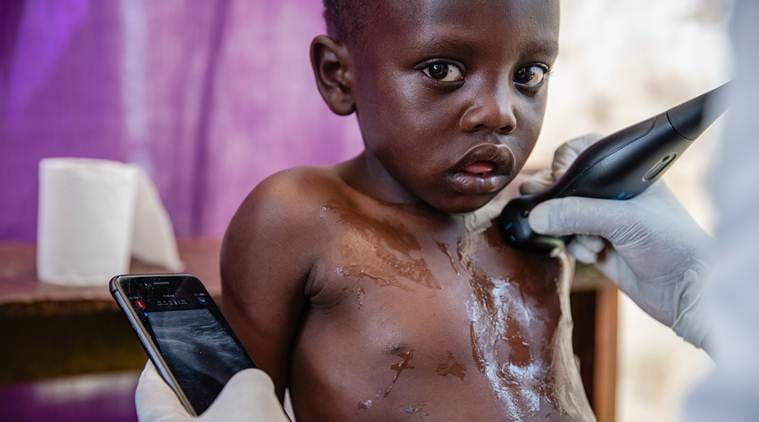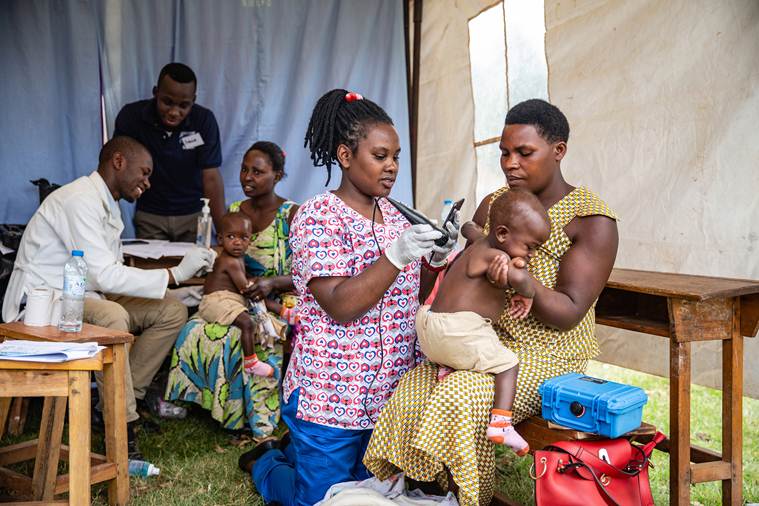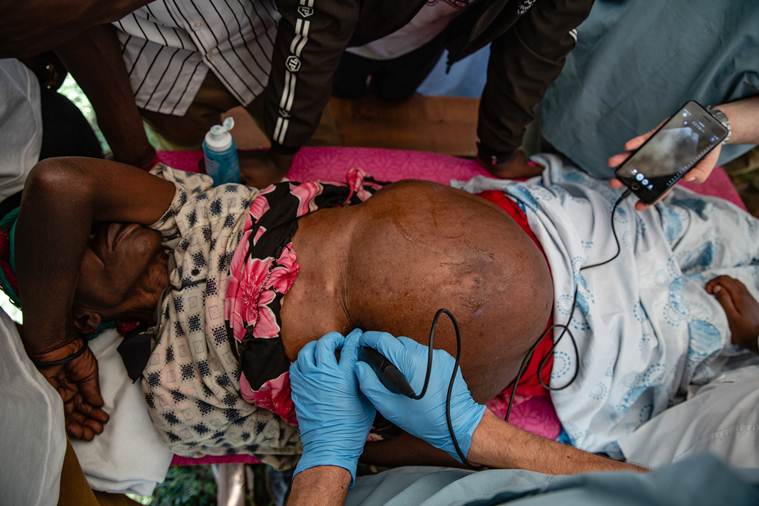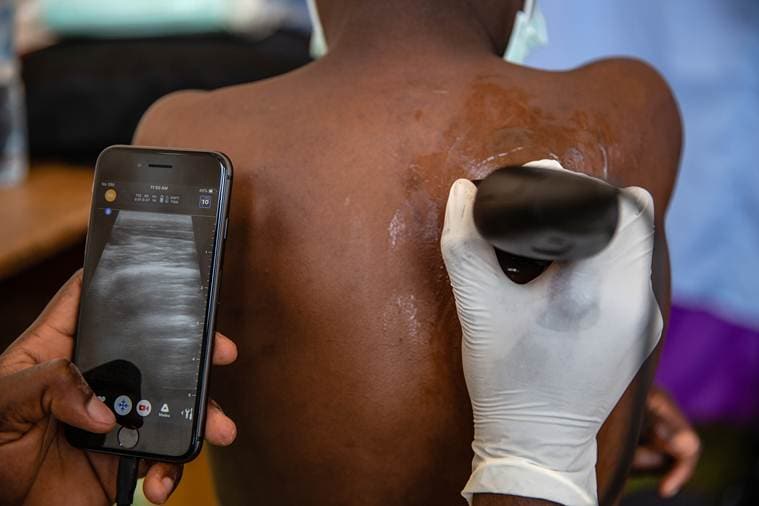
Written by Donald G. McNeil Jr. and Esther Ruth Mbabazi
Bushoro, Uganda — Lying on a church pew with his arm over his head, 6-year-old Gordon Andindagaye whimpered a bit — in fear, not pain — as Dr. William A. Cherniak slowly swept a small ultrasound scanner up and down his chest.
Cherniak and Rodgers Ssekawoko Muhumuza, the Ugandan clinical officer he was training, stared at the iPhone into which the scanner was plugged, watching Gordon’s lung expand and contract.
“OK,” Cherniak finally said. “What do you recommend?”
Gordon had a persistent cough and swollen lymph nodes, and looked tired and unwell. As other boys ran around outside, kicking a soccer ball made of rags and twine, he clung weakly to his mother. The scan on the iPhone’s screen suggested his lungs had fluid in them.
As Cherniak nodded approval, Muhumuza prescribed an antibiotic, and ordered blood tests to rule out tuberculosis, malaria and HIV. He arranged for Gordon and his mother to get a ride to a local clinic for an X-ray and a night of observation.
Cherniak, an emergency medicine specialist from Canada, said he would upload the scan that evening so an ultrasound specialist in Toronto could double-check the diagnosis: early-stage pneumonia.
The diagnosis was made possible by a new invention that Cherniak hopes will revolutionize front-line global medicine: a hand-held ultrasound scanner called the Butterfly iQ.
The Butterfly is about the size of an electric shaver. It is battery-powered and contains microchips rather than piezoelectric crystals, so it usually won’t break if dropped. (That was accidentally tested a few times during a week that a reporter spent in rural Uganda with Cherniak’s team.)

For Butterfly Network, the Connecticut company that makes it, the profitable target customers are doctors and nurses who can afford a $2,000 device that fits in a coat pocket and is as portable as a stethoscope.
But the scanner also has huge potential in rural Africa, Asia and Latin America, where the nearest X-ray machine may be hours away and the only CT and MRI scanners may be in the nation’s capital.
“That was my real motivation for making it,” said Jonathan Rothberg, Butterfly’s founder, who initially pursued the goal because one of his daughters had a disease that caused kidney cysts needing regular scans.
“Two-thirds of the world’s population gets no imaging at all,” he added. “When you put something on a chip, the price goes down and you democratize it.”
The Bill and Melinda Gates Foundation is one of his backers, as are the investment arms of other family philanthropies.
“My team is engineers and computer scientists,” Rothberg said. “We’d love to be able to save lives the way doctors do, but we can’t — so every tweet from Africa about the Butterfly is an incredible adrenaline shot for us.”
He has donated scanners to medical charities working in 13 low-income countries, seven of them in Africa. Several went to Bridge to Health, a Canadian charity that Cherniak founded six years ago; it works closely with Kihefo, a medical charity based in western Uganda.
For now, the scanners are primarily used to check for pneumonia, which is a major killer of children in poor countries and is frequently misdiagnosed. But Cherniak’s team has found other fascinating uses for the devices — which they deployed under conditions almost as stark and dusty as those found in battlefield medicine.
Kihefo runs what might be described as a traveling medical circus. Each day at dawn, its roustabouts drive a truck loaded with collapsible tents into a different village and erect them on whatever flat ground they find — perhaps a patch of goat-gnawed grass between the school and the church.
To improvise examination tables, they borrow the wooden school desks and church pews, pad them with yoga mats and screen them with thin purple curtains.

An hour later, the Canadian-Ugandan “brigade” rolls in — vans full of doctors, nurses, dentists, chiropractors, gynecologists, ophthalmologists and pharmacists, accompanied by local clinical officers and medical students, all toting huge bags of equipment. (Yes, hockey bags — it’s a Canadian charity.)
While the dental team fills cavities and the ophthalmologists check eyes, the medical team sees one patient after another, from newborns to nonagenarians.
On a recent visit to this village, the doctors used their Butterflies not just to screen for pneumonia, but to scan other organs.
Checking a large goiter on the neck of a 42-year-old woman, they learned that it was pressing on her windpipe, meaning she would soon need surgery, even though she had no breathing problems yet.
They scanned the lungs of a frighteningly emaciated baby to see if she had tuberculosis. They scanned the swollen testicle of a 54-year-old man and determined that he probably had cancer rather than their first tentative diagnosis — fluid draining from worm-infested lymph glands.
Scanning the abdomen of a child with a penis birth defect, they learned that his urine was backing up, threatening him with kidney damage — a problem that a simple operation could correct. They scanned a lump in the chest of a 96-year-old man and concluded that it was probably not cancerous because it lacked blood vessels.
Particularly challenging was the case of a 51-year-old woman with a lump on her neck. In part because she described a long history of what sounded like tuberculosis, they initially suspected scrofula.
(Scrofula — once called “the King’s Evil” because medieval monarchs claimed to cure it by touch — is caused by TB bacteria clumping under the skin. )
“I went to a healer who stabbed me with fire,” the woman said, describing a traditional method for draining an abscess: heating a knife in a fire and plunging it into the lump. It hurt a lot and healed nothing, she said.
Scanning the lump, Cherniak saw that it had veins, meaning it was not an abscess and appeared to be attached to a blood vessel.
“See it pulsing away?” he said to his trainee as they looked at his phone. “You don’t want to go anywhere near that. If I did a biopsy, it could bleed a lot. Now I know not to muck around with it and get her to a surgeon.”
Even more mystifying was a woman who appeared to be over 70 but whose belly was so swollen that she looked pregnant.
Doctor after doctor tried scanning her; the gallons of fluid in her abdomen had shoved her organs far from their customary places. Surprisingly, her liver seemed normal — doctors initially had guessed the swelling resulted from alcoholic cirrhosis.
But no one could find her spleen. “What if it’s ALL spleen?” Cherniak mused. “Could it really get that big?”

Various theories — a blocked liver vein, lesions from a sand-fly parasite, a mucus-emitting tumor — were discussed. Finally, all agreed that she needed further scans that only a hospital could do.
The Butterfly’s diagnostic potential is enormous, Kihefo’s founder, Dr. Geoffrey Anguyo, said enthusiastically: “But the question is, how much training is adequate?”
Learning to interpret the fuzzy black-and-white images on a cellphone screen and recognize all the organs, blood vessels, valves and whatnot inside the body — and to do it well enough to spot tumors and other anomalies — is a skill that can take months to learn.
The Gates Foundation, Rothberg said, is writing software intended to guide untrained users as they scan. For now, Bridge to Health is focusing on teaching Kihefo’s clinical officers, who get up to four years medical training but are not physicians, to diagnose pneumonia.
Success will be achieved, Anguyo and Cherniak agreed, when the officers’ diagnoses agree with those of the ultrasound specialists in Toronto at least 80 percent of the time.
That’s where another aspect of the Butterfly comes in handy: iPhones make it easy to upload scans to the internet.